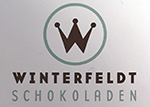In May 2018, Cacaopod and I took a 16-day trip around northern Europe. We had several focuses: art, trains, and chocolate!!! My previous report was on Berlin’s biggest names in chocolate. Now, we tackle the artisan chocolate scene in Berlin.
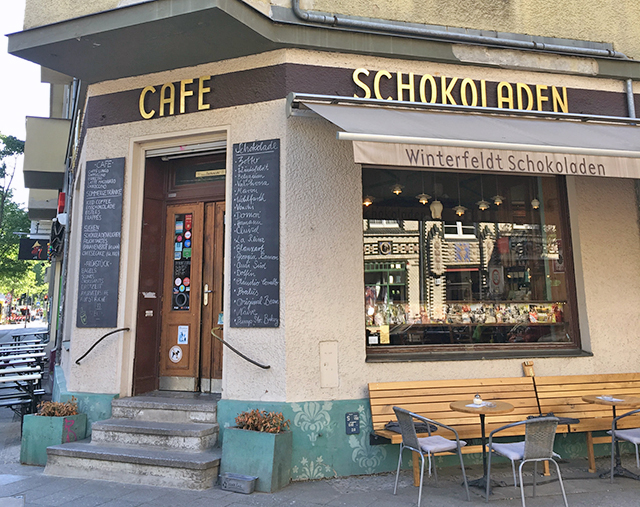
When we told a fellow chocolate enthusiast that Berlin would be one of the stops in our European art & chocolate train trip, he immediately told us we should visit Winterfeld Schokoladen.
He said that they carry a range of European artisan bars, including bars from other Berlin makers. And they make their own chocolate bars and bonbons too. This sounded like a good place to explore since we had only 2 days in a town that’s as sprawling as LA. We got to try a sampling of local artisan chocolate in one stop.
The one stop was even more convenient than expected, because it was in the neighborhood we were staying in. Our place (in addition to being directly above a bakery) was in between Winterfeld Schokoladen and Nollendorfplatz station. Walk 3 blocks in one direction, and all of Berlin and beyond was accessible. Walk 3 blocks the other direction, and lots of Berlin-and-beyond chocolate could be found.
Chocolate as medicine
Winterfeld Schokoladen is a pretty cool place. It’s an old pharmacy that’s been re-purposed. Cabinets and drawers that used to store medicine now store chocolate. In the back they have a small café where they serve coffee, tea, pastries, and chocolate drinks (of course).
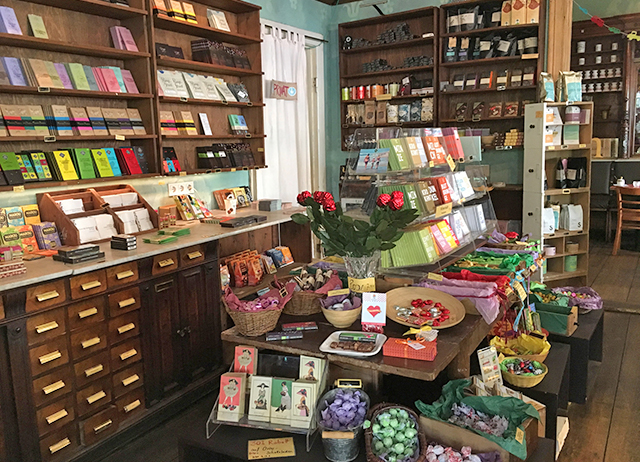

Winterfeld doesn’t have the breadth and depth of the selection at SF’s Chocolate Covered, although they have enough shelf space that they could give them some serious competition. But they had bars I haven’t seen anywhere else, especially their local competitors’ bars, so with the staff’s help, we picked a few out.
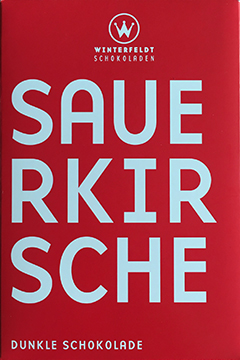

Graphic packaging
We tried a couple of Winterfeld Schokoladen’s own line of chocolate bars: Sauerkirsche (sour cherry) and Minze (mint). I liked the packaging and branding: A solid color box (each flavor is a different color) with the bar’s name filling the front of the box. No attempt was made to break words at syllable breaks; instead words break when they fill the width of the box. Very striking, simple graphic design. The bars looked just as nice: A custom mold of little squares with the Winterfeldt logo (a W that looks like a crown) centered in each square.
I wanted to like these, but I was disappointed. For starters, the bars were too thin: They should be thicker for better mouth feel. The Sauerkirsche was the better of the two: It had big whole dried cherries sprinkled on the back of a 70% dark bar, but the cherries were too dry, so I didn’t like the texture and there wasn’t much of a sour cherry flavor. Plus the initial chocolate taste was off, but it got better as it melted in my mouth.
I didn’t like the Minze at all. It’s also 70% dark bar, but flavored with peppermint oil. It was so astringent, it dried my mouth out like an unripe persimmon. People who tried it said it tasted like mouthwash, only one taster liked it. I think if they had used a lighter hand with the peppermint oil, it would have been OK. I tried another piece of it when writing this review, months later, and it was not so harsh. I guess the oil is evaporating.
Maybe I picked the wrong flavors; Winterfeld Schokoladen has a variety of flavors in both dark and milk chocolate. Maybe if I try some of the others, I will find something I would like. The Blood Orange sounds nice.
Winterfeldt Schokoladen, Goltzstraße 23 / on the corner at Pallasstraße, 10781 Berlin
“…and such small portions”
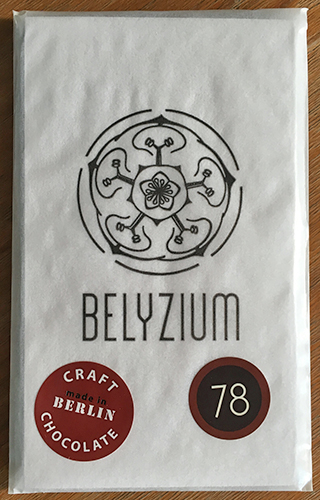

Belyzium is a newer bean-to-bar maker in Berlin, started in 2014. They are pretty hardcore, most of their bars are in the high-70s to 100% cacao. Their one milk bar is almost 70% cacao. They grow their own Criollo/Trinitario beans organically in Belize (hence their name) and process them into bars in their chocolaterie in Berlin, where they also sell their products and offer workshops.
We got the lowest percentage bar Winterfeld carried, a 78%. I liked Belyzium’s unique packaging: Double wax paper envelopes with one-color ink printing and some stickers to seal the package and also provide information about the chocolate inside. Supporting the bar inside was a postcard-like insert with more information about their chocolate.
The bar itself had an elaborate custom mold, similar to the package art of the logo but adding a cacao flower. Very pretty, however the bar was too thin and brittle. It broke before I could take a picture of it. It’s the thinnest chocolate bar I’ve ever had — about the thickness of a slice of thick-cut bacon.
Along with being too thin, it tasted woody/earthy and bitter. Bitter was not a surprise because of its high cacao content, but I was disappointed that the chocolate did not have a more luxurious taste since it was made with high quality beans. It lacked a good mouth feel with a grainy texture and powdery after-texture.
Bean to bar can be hit or miss depending on the particular batch because there is no blending done to achieve a consistent taste profile, so maybe I just picked a less-than-stellar bar, and other Beyzium bars are better. I give them plusses for their packaging and branding, but I think their bars would be better if they were thicker and had a smoother texture.
Belyzium Craft Chocolate: Lottumstraße 15, 10119 Berlin


Can’t catch a break
From one of the newest Berlin bean-to-bar makers to one of the oldest, we also tried a 78% from pioneer Berlin chocolate maker Holger in’t Veld’s latest incarnation, theobromine.ma. Herr in’t Veld has been making and selling chocolate in Berlin since at least 2002, but has gone bankrupt several times. Each time he comes back with a new concept. This time, he calls it “garage chocolate.”
He seems to have suffered another setback recently. Sometime since we visited Berlin and I started to write this article, his current place of business caught fire and he is not making or selling chocolate now. His website sounds like he is not calling it quits yet, so stay tuned.
That being said, the theobromine.ma bar we tried, I did not care for. The 78% Peru “Rockers” from their Jungle Please series lists just 3 ingredients: Trinitario cacao, raw sugar, and cocoa butter. I found it too bitter, very raisiny, and strongly fermented. It was also super grainy, with an overload of cacao bits. One of my tasters said, “They are there on purpose, but they are not helping. It tastes more like an energy bar than a chocolate bar.”
In’t Veld by Theobro.ma, Schönhauser Allee 50A, 10437 Berlin
Solidly mysterious
Things improved with our next selection, La Reina No. 1 from bean-to-bar maker CCB Cacao Contour Berlin, although the company itself is a little mysterious. They have almost zero Internet presence, not even on the Winterfeld site, so I don’t know if they have gone out of business or if they are just anti-social media.
La Reina No. 1 is a 70% dark chocolate made with beans from Panama that are certified sustainable farmed, plus raw cane sugar. The bars are small squares, about 3″x3″, with a simple, but pretty diamond pattern mold. Personally, I think they should make bigger, more conventionally sized bars: while the packaging is attractive, I fear it gets overlooked next to the more common larger rectangular bars.
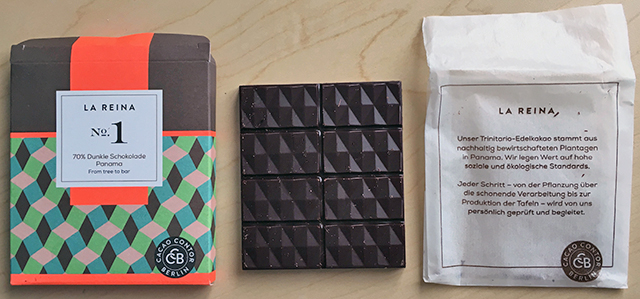

Even with the small size and lack of Internet presence, I hope these makers continue with their enterprise. They make good chocolate, at least based on this bar. It was a decent bar, with a good snap and overtones of honey and raisin. It tasted darker than a 70%, but it wasn’t bitter. And it had a nice lingering raisin aftertaste.
CCB Cacao Contour Berlin, Mohrenstraße 34, 10117 Berlin
The Berlin experience
The last Berlin chocolatier whose wares we sampled seem to epitomize our Berlin chocolate experience. Environmentally responsible Wohlfarth Schokoladen creates a wide range of chocolate products with an emphasis on the creative, but the results were varied.
Their certified organic chocolate includes all organic ingredients and comes in attractive plastics-free packaging. In addition to bars, drinking chocolate, and novelty chocolates, they also sell beans — including ones with dried cacao fruit still attached. So far, so good.
Lost in translation
I love the idea of neighborhood-inspired chocolates, and Wohlfarth Schokoladen’s chocolatier Christoph Wohlfarth collaborated with local writer Tanja Dückers to create a Berlin neighborhood collection. The staff at Winterfeld explained to us that it’s supposed to be a somewhat humorous or offbeat take on the neighborhoods, so it helps to know something about the places to appreciate what they have done.
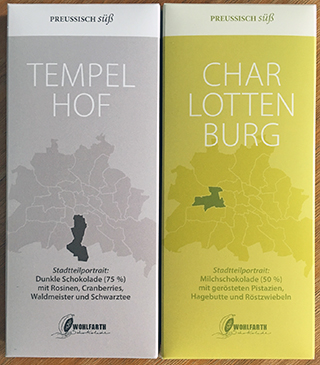

We tried a couple of the bars, one milk and one dark, from their Preussisch-suess, Berliner Stadtteilschokolade collection of 15 bars, each representing a different district/neighborhood of Berlin. Maybe a different bar would have been a better choice for me; I found these 2 weird. So weird that I dreaded trying them again to refresh my memory as I wrote this.
Clash of flavors
The Charlottenburg bar, I was told, celebrates the Hausbesitzers, the squatters of the late 1960s German Student Movement rebellion, who lived in abandoned apartments in the Charlottenburg neighborhood, which is now a rather posh place. It’s a 50% milk chocolate bar with roasted pistachio, rosehips and fried onion. I think they were going for conflicting flavors to evoke the protests and rioting of ‘68.
It’s a good milk chocolate, but with an onion aftertaste. I guess it’s better that I didn’t taste the onion until afterwards, but I don’t get it. Plus the pistachio was hard crunchy bits — like there were shells or dirt in it, just unpleasant.
You say vanilla, I say soap; you say kerosene, I say ???
The other bar we tried, Templehof, is named after the historic former airport in Berlin turned into a huge park. It’s a 75% dark bar with raisins, cranberries, black tea and Waldmeister, an herb the staff told us blooms in spring and tastes like vanilla. I had never heard of it, so I looked it up. It is known in English as woodruff, and I’m not sure it’s available in the U.S., but in Europe it’s used as a flavoring agent.
The Winterfeld staff told us that Waldmeister grows wild at Templehof, so using that herb instead of vanilla makes sense, but it didn’t taste like vanilla to me: it was more herbaceous, soapy, almost Chinese medicine-like. The dried fruits were nice pops of sweet flavors, but the black tea, which the writer claims is evocative of kerosene (?! — an homage to when it was an airport) was crunchy bits sprinkled on the bar, not the typical flavor infusion, so it was weird and added a dusty overtone.
Still better than the onion bar, though.
Chocolate Salami


In addition to the novel takes on neighborhoods, Wohlfarth makes a variety of novelty chocolates include playable chocolate records (with a range of recordings from the Beach Boys “Surfing’ U.S.A.” to German comedy routines) and chocolate salami. We got one of the “sausages” and really enjoyed it.
The sausages are not another crazy combo of ingredients: There’s no meat; instead they’re made of common candy ingredients fashioned to look like salami.
They combine chocolate and nougat into cylinders and roll them in powdered sugar. The powdered sugar mimics the casing on a salami. Crunchy bits of roasted hazelnuts inside are the “fat flecks” you see in salami. Visually, if you didn’t know it was chocolate, you could be tricked into thinking it’s real salami.
The chocolate is good, on the sweet-ish side, with a creamy texture — similar to fudge in taste, but without the graininess. We loved the pronounced nuttiness, and it was a chocolate that travels well, so it would make good gifts to bring home from Berlin. There’s also an “over 18” version that includes raisins soaked in rum for the adults on your list.
Wohlfarth Schokoladen, Choriner Str. 37, 10435 Berlin
Serious chocolate, but slightly silly too
Summing up our Berlin artisan chocolate experience, I’d note that is a lot happening there, although it’s not as big or robust a scene as our local one yet. They are serious about certain aspects of chocolate making: Organic is a must; fair trade is important; most bars contain no soy lecithin or other preservatives. Their packaging is interesting, often eye-catching. But I wish they were as into making delicious chocolate as they are into making socially sustainable chocolate. I was more disappointed than delighted overall with Berlin artisan chocolate.
I do appreciate their lightheartedness, even if I didn’t always appreciate the execution. There is a silly streak in German culture that I like. It first struck me when I was in Germany in the late 70’s, and Udo Lindenberg was a big rock star (now an icon) there, but most of his songs I heard were really silly (here’s an English version of one of his then-hits). Chocolate salami, neighborhood-inspired weirdness, and garage chocolate are just current expressions of the same low-key silliness that Germans share.
Next stop: Amsterdam’s Cacaomuseum

